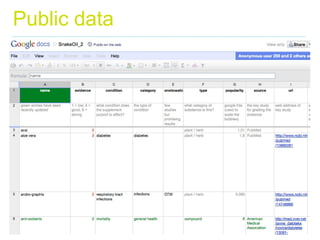A short history of infographics
- 1. Page 1 | Infographics | April 2012 Infographics a short history
- 2. Page 2 | Infographics | April 2012 Definition Infographics = information graphics ŌĆ£graphic visual representations of information, data* or knowledge. These graphics present complex information quickly and clearlyŌĆØ - Wikipedia *aka data visualisation Bar charts and maps, line graphs, pie charts, system diagrams, tablesŌĆ”
- 3. Page 3 | Infographics | April 2012 Purpose Shifts the balance between perception and cognition to take fuller advantage of the brain's abilities
- 4. Page 4 | Infographics | April 2012 Principles Proximity Objects that are close together are perceived as a group Similarity Objects that share similar attributes (e.g. color or shape) are perceived as a group Connection Objects that are connected (e.g. by a line) are perceived as a group
- 5. Page 5 | Infographics | April 2012 Principles Enclosure Objects that appear to have a boundary around them (e.g. formed by a line or area of common colour) are perceived as a group Closure Open structures are perceived as closed, complete, and regular whenever there is a way that they can reasonably be interpreted as such Continuity Objects that are aligned together or appear to be a continuation of one another are perceived as a group Connection Objects that are connected (e.g. by a line) are perceived as a group
- 6. Page 6 | Infographics | April 2012
- 7. Page 7 | Infographics | April 2012 Origins Cave paintings! Maps pre-date writing by several millennia An early infographic that made a differenceŌĆ” In 1857, English nurse Florence Nightingale used information graphics persuading Queen Victoria to improve conditions in military hospitals, principally the Coxcomb chart, a combination of stacked bar and pie charts, depicting the number and causes of deaths during each month of the Crimean War.
- 8. Page 8 | Infographics | April 2012 Origins
- 9. Page 9 | Infographics | April 2012 Modern infographics
- 10. Page 10 | Infographics | April 2012 Research centric Lauren Manning, a New York based designer, explores various methods to visualise one single data set for her thesis. Food Consumed: ŌĆ£ItŌĆÖs like comparing apples to oranges.ŌĆØ This phrase is the best way to describe the current state of data visualizations. ŌĆ”Instead of seeing many excellent visualizations of all different data sets, what if you could see tons of visualizations of the same data set? What new comparisons, knowledge and structure might be developed from this?
- 11. Page 11 | Infographics | April 2012 Research centric Lauren Manning, a New York based designer, explores various methods to visualise one single data set for her thesis. Food Consumed: ŌĆ£ItŌĆÖs like comparing apples to oranges.ŌĆØ This phrase is the best way to describe the current state of data visualizations. ŌĆ”Instead of seeing many excellent visualizations of all different data sets, what if you could see tons of visualizations of the same data set? What new comparisons, knowledge and structure might be developed from this?
- 12. Page 12 | Infographics | April 2012 Research centric
- 13. Page 13 | Infographics | April 2012 Customisable
- 14. Page 14 | Infographics | April 2012 Public data research centric and attributed to multiple sources
- 15. Page 15 | Infographics | April 2012 Attributed to multiple sources Blog data comes from a variety of online sources, including LiveJournal, MSN Spaces, MySpace, Blogger, Flickr, Technorati, Feedster, Ice Rocket, and Google.
- 16. Page 16 | Infographics | April 2012 RSPCA Freedom Food sales data visualisation We produced assets to reach out to bloggers and online influencers, providing visuals to support a statistics based PR story. Very successful campaign results for RSPCA.
- 17. Page 17 | Infographics | April 2012 Channel 4 ŌĆśAsk the ChancellorsŌĆÖ debate
- 18. Page 18 | Infographics | April 2012 Datacopter Twitter visualisation app for Channel 4
- 19. Page 19 | Infographics | April 2012 Datacopter Twitter visualisation app V2.0
- 20. Page 20 | Infographics | April 2012 Barclaycard: influencer mapping
- 21. Page 21 | Infographics | April 2012 notaninfographic.tumblr.com
- 22. Page 22 | Infographics | April 2012 Thank you! @bethgranter http://delicious.com/bethgranter/infographics






















